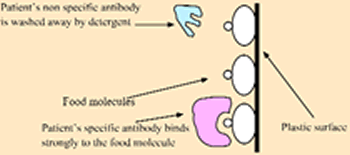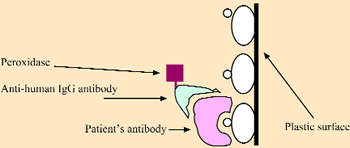Positive Health Online
Your Country

Development of Test Systems for Allergy Testing: An Immunologist's Viewpoint
by Dr Michael Walker(more info)
listed in allergy testing, originally published in issue 28 - May 1998
An increasing number of people appear to be suffering from diseases which involve the immune system and sensitivity to different foods. Since the clinical problems occur some time after eating the trigger foods, we refer to these as hidden food sensitivities. In some patients this is reflected in an immune response to specific food proteins. Raised levels of food specific antibodies of the IgG, IgA and IgM classes can often be demonstrated in the serum of patients with food sensitivity, however, apparently normal individuals rarely have such antibodies.
Why patients produce antibodies to foods is not clearly understood at this time, however, it has been shown that if the reactive foods are removed from the diet, a significant number of patients see an improvement in their condition and general well-being.
Diagnostic methods for food sensitivity have been subjective and unreliable because of their poor reproducibility and accuracy. The most successful tests are those which test the immune reactions produced by different foods. To address some of these problems Dr Walker's team have developed an ELISA screening test which directly measures the activity of serum antibodies to a panel of 90 foods directly in a test plate. The test method is completely objective since it produces a photometric end-point.
Development of the food antibody assay system
The first stage is deciding which foods to include in the test panel and which to miss out. By consulting with nutritional experts we drew up a list of candidate foods which from experience were likely to cause sensitivity problems. These foods are shown in Table 1 below.
|
Table 1:
Ninety Food Antibody test
|
|||
|
Grains Dairy Foods Beef Chicken Lamb pork Turkey Venison |
Fish Cod Crab herring Lobster Mackerel Mussel Plaice Prawn Salmon Sole Trout Tuna Vegetables Aubergine Avocado Beetroot Broccoli Cabbage Carrot Cauliflower Celery Cucumber Lettuce Onion Parsnip Peas Peppers Potato Spinach |
Beans Haricot Bean Kidney Bean Leek Lentil Soya Bean String Bean Fruits Apple Apricot Banana Blackcurrant Grapes Grapefruit Kiwi Fruit Lemon Melon Olive Orange Peach Pineapple Plum Strawberry Tomato |
Nuts Almond Cashew Coconut Hazelnut Peanut Walnut Miscellaneous Chilli Pepper Garlic Pepper Black/White Sesame Seed Sunflower Seed Tobacco Smoke Chocolate Coffee Cola Nut Mushroom Cane Sugar Tea Yeast (Brewer's / Baker's Mix |
Most foods are not suitable for use in the test in their raw form, and must be carefully processed by a variety of biochemical techniques to produce a relatively "pure" extract which contains the major proteins. The protein extract is then co-valently coated onto the surface of a polystyrene microtitre plate using proprietary technology developed at Genesis Diagnostics Ltd. Once fixed in position on the surface of the microtitre plate, the food extracts can be used in a food antibody test which relies on the very specific interaction between an antibody and its corresponding "food antigen". (See figure 1 below)

Figure 1 Showing the plastic surface of the microplate with food proteins immobilised onto the surface.
The coating process is repeated for all the required foods. Careful attention is given to the protein concentration of each food so that each one gives a similar response in the final assay enabling the concentration of one food antibody to be compared to another.
Once the food coated microplates have been prepared and stabilised, they are foil packed and will keep for up to 18 months.
The coated microplates are used in the following way.
The test involves three stages
Recognition and immobilisation of specific food antibodies
Removal of non specific antibodies using detergent solution
Visualisation and measurement of the concentration of specific food antibodies
1 Recognition of specific food antibodies
When a dilute solution of blood is allowed to come into contact with the plastic surface previously coated with food protein, any antibodies which recognise the food protein will become bound onto it like a key in a lock. (See figure 2 below)

Figure 2 Showing how different types of antibodies react with the food molecules.
2 Removal of non-specific antibodies
All other antibodies which do not recognise food do not bind and are washed away leaving only specific antibodies on the plastic surface. This is achieved by emptying the contents of the microplate and rinsing each well with buffer containing a detergent three to four times.
3 Visualisation of the antibodies
Any antibody which has bound to food molecules is retained after washing the microplate. To check if antibodies have bound to the plastic, an enzyme labelled antibody which is specific for human IgG is used. We use a goat-anti-human IgG antibody which has been chemically linked to a plant enzyme known as Horse-radish Peroxidase.
Various classes of antibody can be detected in this way, for example IgM, IgA and IgE. However, IgG is quantitatively the most important. IgG can be split further into four subclasses, and IgG subclass four has been implicated as important in some studies, however, the evidence is not conclusive and for this reason total IgG is preferred.
Each molecule of human antibody attached to the microplate is tagged by an anti-human IgG antibody-peroxidase molecule, as shown in figure 3 below. Any anti-human antibody which has not bound is washed away in a second series of rinsing stages using detergent solution.

Figure 3 Showing attachment of peroxidase labelled goat-anti-human antibodies to the patient's antibody.
The peroxidase molecule is an enzyme which has the property of transforming a clear solution into a coloured solution very quickly. This is the reaction that causes apples to go brown when they are damaged. The intensity of the colour produced is in direct proportion to the enzyme concentration and therefore to the original patient antibody concentration as shown in figure 4 below.

Figure 4 The enzyme converts a clear solution to intense yellow colour which absorbs light at 450 nanometers.
By comparing the colour intensity for each of the 90 foods to a set of calibrators, a concentration level can be calculated for each individual food. The colour density readings are performed in a microplate spectrophotometer as shown in figure 5 below.

Figure 5 Finger prick device/blood collection
Quality control and clinical studies
We have tested repeat samples to show that we get the same pattern of reactive foods every time the assay is run. The assay is very reproducible and it always gives the same pattern of food reactions when split patient samples are tested. Even different samples from the same patient taken several months apart will give similar results provided the patient's diet is stable.
Each time a new batch of test kits is made, a panel of patients with different food antibody patterns is used to assess the batch. In addition a control sample is included in the test kit so that laboratories who use our test kits can make a control check on each patient.
By testing large numbers of normal individuals, we have determined that values up to 12 U/ml of antibody is normal Values up to 25 U/ml are regarded as mild and above 50 U/ml as strong reactions.
It should be remembered, however, that the antibody concentration may not always reflect the severity of the problem. Some patients also have immune insufficiency diseases which may affect the results.
We have screened over 50 normal individuals without any apparent food sensitivity problems. In these apparently healthy individuals, the food antibody values were below 12 U/ml. In food sensitive individuals the immune reactions are very specific. For example most food reactions will be in the normal range except for isolated strong reactions to particular foods. This indicates that the patient has a specific anti-food reactions and the mechanism is unlikely to be due to simple leakage of food through the gut.
Often we see dramatically raised food IgG reactions in patients with suspected food sensitivity problems. For example, a raised level of milk antibodies of 100 U/ml or greater, often accompanied by lower levels for yoghurt and cheese and other milk related products. In other patients general grain reactions are observed with some or all grain antibodies raised. Sometimes only single grains such as wheat or oats react strongly. In other patients we have seen strong reactions to eggs, nuts, beans, olives, tomatoes or fish. The results can often be quite surprising.
The results can then be incorporated into planning an exclusion diet, avoiding completely all strongly reacting foods for a trial period of 3 – 6 months.
The food test is available world-wide from Immunology @ Home, a specialist service laboratory based in Cambridgeshire.
The food IgG test requires only a small amount of capillary blood. Samples can collected at home and sent by post to our laboratory. On ordering a test, a special blood collection kit is sent to the patient which allows blood to be collected at home.
Comments:
-
No Article Comments available